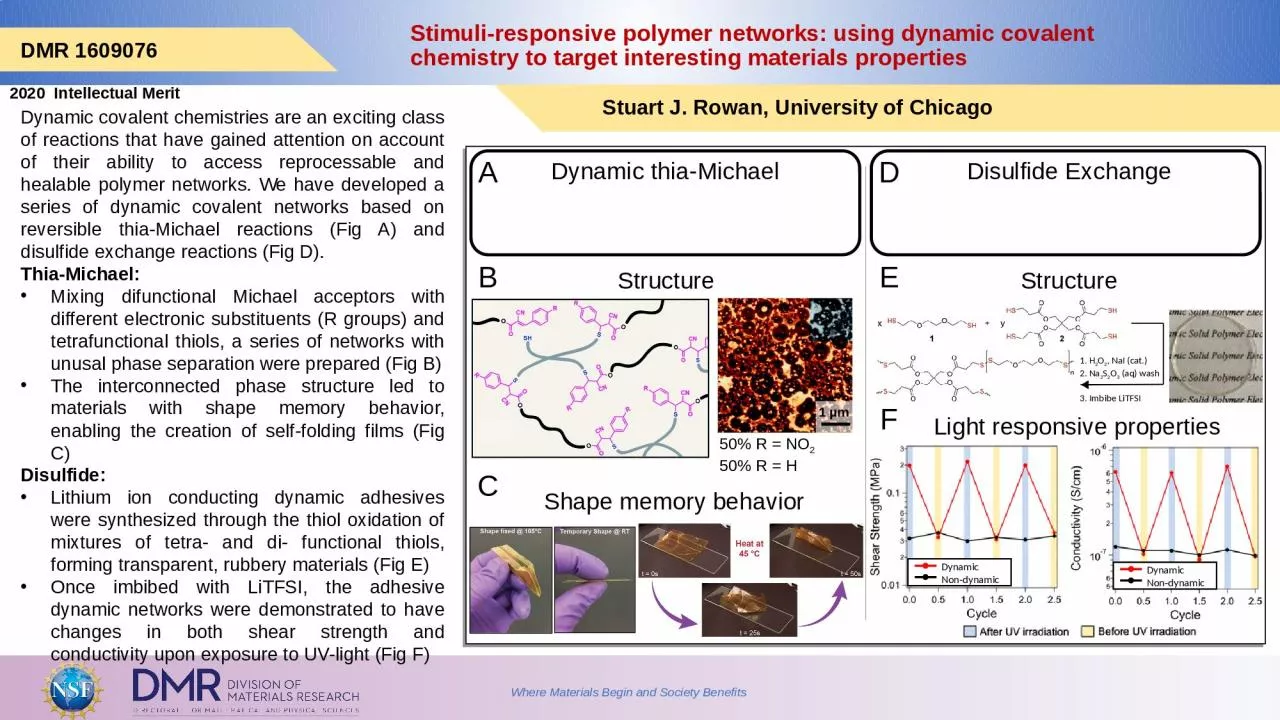

DMR 1609076 2020 Intellectual Merit Stuart J Rowan University of Chicago Dynamic covalent chemistries are an exciting class of reactions that have gained attention on account of their ability to access reprocessable and healable polymer networks We have developed a series of dynamic covalent ID: 999234
Download Presentation The PPT/PDF document "Stimuli-responsive polymer networks: usi..." is the property of its rightful owner. Permission is granted to download and print the materials on this web site for personal, non-commercial use only, and to display it on your personal computer provided you do not modify the materials and that you retain all copyright notices contained in the materials. By downloading content from our website, you accept the terms of this agreement.
1. Stimuli-responsive polymer networks: using dynamic covalent chemistry to target interesting materials propertiesDMR 16090762020 Intellectual MeritStuart J. Rowan, University of ChicagoDynamic covalent chemistries are an exciting class of reactions that have gained attention on account of their ability to access reprocessable and healable polymer networks. We have developed a series of dynamic covalent networks based on reversible thia-Michael reactions (Fig A) and disulfide exchange reactions (Fig D).Thia-Michael: Mixing difunctional Michael acceptors with different electronic substituents (R groups) and tetrafunctional thiols, a series of networks with unusal phase separation were prepared (Fig B)The interconnected phase structure led to materials with shape memory behavior, enabling the creation of self-folding films (Fig C)Disulfide:Lithium ion conducting dynamic adhesives were synthesized through the thiol oxidation of mixtures of tetra- and di- functional thiols, forming transparent, rubbery materials (Fig E) Once imbibed with LiTFSI, the adhesive dynamic networks were demonstrated to have changes in both shear strength and conductivity upon exposure to UV-light (Fig F)Disulfide ExchangeDDynamic thia-MichaelAShape memory behaviorCBStructure50% R = NO250% R = H1 µmStructureE1. H2O2, NaI (cat.)2. Na2S2O3 (aq) wash3. Imbibe LiTFSIFLight responsive properties Dynamic Non-dynamic Dynamic Non-dynamic
2. Stuart J. Rowan, University of ChicagoResearchers use hands on demonstrations to explain concepts of polymer science at the Cleveland Museum of Natural History2020 Broader ImpactsThe group participated in the 2020 MLK ‘Discovery Day’ event at the Cleveland Museum of Natural History, attended this year by ~600 people of all ages. This free event had 6 tables of experiments that encouraged guests to interact directly with concepts in polymer science (Fig A). The tables were manned by 18 graduate students (GS) and postdocs from the Rowan group (University of Chicago, UofC) and students from Case Western Reserve University. Christopher Eom and Elise Chen (both GS, UofC) used non-Newtonian fluids to introduce visitors to concepts of viscoelasticity (Fig B). Neil Dolinski (PD, UofC) described the effects of crosslinking polymers, while helping guests make bouncy balls to take home (Fig C). Benjamin Rawe (PD, UofC) and Nicholas Boynton (GS, UofC) used liquid nitrogen to cool various polymers below their glass transition temperature (Fig D). Nicholas Macke introduced the visitors to super absorbent polymers, making ‘fake snow’ by adding water to polymeric powders (Fig E).ABCDEDMR 1609076